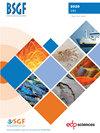来自法国南部loz地区Causse msamujean晚侏罗世石质石灰岩的陆生植物和海藻
IF 2.6
3区 地球科学
Q2 GEOSCIENCES, MULTIDISCIPLINARY
引用次数: 2
摘要
在Lozere(法国南部)的Causse Mejean的石质石灰岩中发现了一种新的晚侏罗世植物群。它由来自该地区的第一批基默里吉纪/提桑纪植物组成。化石植物的代表是作为印痕保存下来的巨型化石。这个植物群显示了陆生植物和海洋藻类的共存。陆地植物包括属于bennettitaleans (Zamites Brongniart, 1828年)、针叶树(Brachyphyllum Brongniart, 1828年)和蕨类植物(Cycadopteris Zigno, 1853年)的营养遗迹。海藻被归为水藻类(Goniolina D’orbigny, 1850)。岩石学和古生物学特征表明保存在平坦、均匀、受保护的环境中,可能是受大陆和海洋输入影响的咸淡水或海洋泻湖。这一发现补充了欧洲晚侏罗世植物区系的少数现有报告,并表明沿海栖息地主要是亚乔木植被,包括贝尼塔利亚和翼蕨植物,以及乔木植物,如针叶树。古环境背景和某些旱生特征表明,这些来自梅让山脉的陆生植物很好地适应了沿海地区炎热干燥的环境。本文章由计算机程序翻译,如有差异,请以英文原文为准。
Terrestrial plants and marine algae from the Late Jurassic lithographic limestone of the Causse Méjean (Lozère, southern France)
A new Late Jurassic flora was discovered in the fossiliferous lithographic limestone of the Causse Mejean, Lozere (southern France). It consists of the first Kimmeridgian/Tithonian plants from this area. Fossil plants are represented by megaremains preserved as impressions. This flora shows a co-occurrence of terrestrial plants and marine algae. The land plants include vegetative remains ascribed to bennettitaleans (Zamites Brongniart, 1828), conifers (Brachyphyllum Brongniart, 1828), and pteridosperms (Cycadopteris Zigno, 1853). Marine algae were ascribed to dasyclads (Goniolina D’Orbigny, 1850). Lithological and palaeontological features suggest preservation in a flat, homogeneous, protected environment, perhaps a brackish or marine lagoon, influenced by both continental and marine inputs. This discovery complements the few existing reports of European Late Jurassic floras, and indicates that coastal habitats were dominated by sub-arborescent vegetation, consisting of bennettitaleans and pteridosperms, and arborescent plants, such as conifers. Both the palaeoenvironmental context and certain xerophytic features suggest that these terrestrial plants from the Causse Mejean were well adapted to the hot, dry conditions of coastal areas.
求助全文
通过发布文献求助,成功后即可免费获取论文全文。
去求助
来源期刊
CiteScore
5.80
自引率
0.00%
发文量
18
审稿时长
>12 weeks
期刊介绍:
BSGF - Earth Sciences Bulletin publie plusieurs types de contributions :
1. des articles originaux, couvrant tous les champs disciplinaires des Géosciences, à vocation fondamentale mais également à vocation plus appliquée (risques, ressources);
2. des articles de synthèse, faisant le point sur les avancées dans un domaine spécifique des Géosciences, qu''elles soient méthodologiques ou régionales ;
3. des monographies sur la géologie d’une région donnée, assorties d’informations supplémentaires, cartes, coupes, logs, profils sismiques … publiées en ligne en annexe de l’article ;
4. des articles courts de type « express letter » ;
5. des livrets-guides d’excursion (qui suivront le même processus d’examen éditorial que les articles plus classiques) ;
6. des comptes rendus de campagnes à la mer ;
7. des articles de données géodésiques, géophysiques ou géochimiques, pouvant devenir des articles de référence pouvant conduire à des interprétations ultérieures.
BSGF - Earth Sciences Bulletin constitue également un forum pour les discussions entre spécialistes des Sciences de la Terre, de type comment-reply ou autre. Tous les articles publiés, quelle que soit leur forme, seront accessibles sans frais (articles en Open Access) sur le site de la SGF et sur celui de Geosciences World dans la mesure où les auteurs se seront acquittés d’une contribution de (Article Processing Charges – APC) de 300€ pour les membres de la SGF et 500€ pour les non-membres.

 求助内容:
求助内容: 应助结果提醒方式:
应助结果提醒方式:


